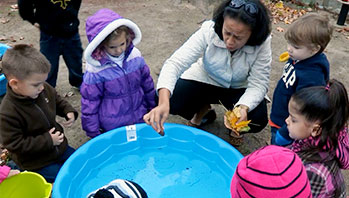- camera (optional)
- clipboard
- digging tools or sticks
- garden hose
- markers
- paper
- water containers (plastic buckets, bottles, and cups)
- flow
- pool
- turn
- water
MA Standards:
Language/L.PK.MA.6: Use words and phrases acquired through conversations, listening to books read aloud, activities, and play.
MA Draft STE Standards:
Earth and Space Sciences/Earth’s Systems/ESS2.A: Observe, investigate, and classify the non-living materials, natural and human made, in their environment.
Earth and Space Sciences/Earth’s Systems/ESS2.C: Explore and describe the different places water is found in the local environment.
Head Start Outcomes:
Logic and Reasoning/Reasoning and Problem Solving: Classifies, compares, and contrasts objects, events, and experiences.
Science Knowledge/Conceptual Knowledge of Natural and Physical Worlds: Observes, describes, and discusses properties of materials and transformation of substances.
Science Knowledge/Scientific Skills and Method: Collects, describes, and records information through discussions, drawings, maps, and charts.
PreK Learning Guidelines:
English Language Arts/Language 2: Participate actively in discussions, listen to the ideas of others, and ask and answer relevant questions.
Science and Technology/Inquiry Skills 4: Record observations and share ideas through simple forms of representation such as drawings.
Science and Technology/Earth and Space Sciences 5: Compare and contrast natural materials such as water, rocks, soil, and living organisms using descriptive language.
Science and Technology/Physical Sciences 19: Explore, describe, and compare the properties of liquids and solids found in children's daily environment.
Explore Together (outdoors): Turns and Pools

© Commonwealth of Massachusetts, Department of Early Education and Care (Jennifer Waddell photographer). All rights reserved.
STEM Key Concepts: Water flows downhill; You can change the direction water flows; Some surfaces absorb water, some don’t; You can use different objects to move water
ELA Focus Skills: Listening and Speaking, Vocabulary
Educator Prep: You may want to provide water smocks (garbage bags with holes for head and arms work well) to help keep children dry. Set guidelines about splashing and squirting.
Take children outdoors to continue exploring the flow of water. Make sure to review any rules and guidelines with children before beginning.
As in Week 1, find a sloping area of dirt or blacktop. Have children pour water from a container or use a hose to make a flow of water. Have them pour slowly so that the water flows in a slow stream. Before they pour, ask them to predict where the water might flow based on what they have observed about water flow since last week. After they pour, ask, Was your guess right? Why do you think the water flows in that direction?
Before having children pour more water, set a new frame for exploration by asking, How do you think we could change the path of the rivers we are making to create new turns and puddles, or pools? Acknowledge children’s responses and emphasize using materials to block the path of the water to change or stop its flow. Help children collect materials (stones, twigs, leaves, etc.) that they can use to block and change the water flow. Encourage children to use a variety of materials and to notice what happens with each. For example, ask,
- Why did you arrange the stones that way? What happens to the water when you do that?
- Where do pools form? Where does the water turn?
- What happens to the water when you use the stones to block the flow? What happens to the water when you use the twigs?
Take photographs and/or video children as they work.
Reflect and Share
Once inside, talk with children about what they observed. Review any photographs or video recordings you made of children’s explorations. Help them reflect on how the water moved. For example, ask,
- Which materials worked best for changing the flow of water?
- Do some materials work better for making puddles and pools? For making turns? Why do you think so?
Take It Further: As children are gathering materials outdoors, take the opportunity to note materials that are natural and materials that are human-made. Distinguish what is trash and say, It’s important not to leave things like this to pollute the environment, or the place where we live. It’s important to keep outdoor areas clean.
